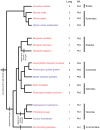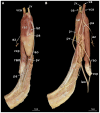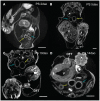Heterochrony and early left-right asymmetry in the development of the cardiorespiratory system of snakes
- PMID: 25555231
- PMCID: PMC4282204
- DOI: 10.1371/journal.pone.0116416
Heterochrony and early left-right asymmetry in the development of the cardiorespiratory system of snakes
Abstract
Snake lungs show a remarkable diversity of organ asymmetries. The right lung is always fully developed, while the left lung is either absent, vestigial, or well-developed (but smaller than the right). A 'tracheal lung' is present in some taxa. These asymmetries are reflected in the pulmonary arteries. Lung asymmetry is known to appear at early stages of development in Thamnophis radix and Natrix natrix. Unfortunately, there is no developmental data on snakes with a well-developed or absent left lung. We examine the adult and developmental morphology of the lung and pulmonary arteries in the snakes Python curtus breitensteini, Pantherophis guttata guttata, Elaphe obsoleta spiloides, Calloselasma rhodostoma and Causus rhombeatus using gross dissection, MicroCT scanning and 3D reconstruction. We find that the right and tracheal lung develop similarly in these species. By contrast, the left lung either: (1) fails to develop; (2) elongates more slowly and aborts early without (2a) or with (2b) subsequent development of faveoli; (3) or develops normally. A right pulmonary artery always develops, but the left develops only if the left lung develops. No pulmonary artery develops in relation to the tracheal lung. We conclude that heterochrony in lung bud development contributes to lung asymmetry in several snake taxa. Secondly, the development of the pulmonary arteries is asymmetric at early stages, possibly because the splanchnic plexus fails to develop when the left lung is reduced. Finally, some changes in the topography of the pulmonary arteries are consequent on ontogenetic displacement of the heart down the body. Our findings show that the left-right asymmetry in the cardiorespiratory system of snakes is expressed early in development and may become phenotypically expressed through heterochronic shifts in growth, and changes in axial relations of organs and vessels. We propose a step-wise model for reduction of the left lung during snake evolution.
Conflict of interest statement
Figures

















References
-
- Cardoso WV, Lü J (2006) Regulation of early lung morphogenesis: questions, facts and controversies. Development 133:1611–1624. - PubMed
-
- Cardoso WV (2001) Molecular regulation of lung development. Annu Rev Physiol 63:471–494. - PubMed
-
- Lin CR, Kioussi C, O’Connell S, Briata P, Szeto D, et al. (1999) Pitx2 regulates lung asymmetry, cardiac positioning and pituitary and tooth morphogenesis. Nature 401:279–282. - PubMed
Publication types
MeSH terms
LinkOut - more resources
Full Text Sources
Other Literature Sources

